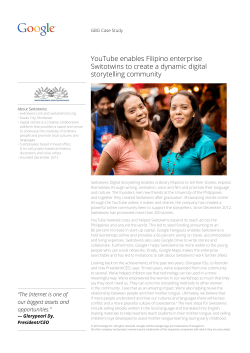
1. A Laboratory Pattern Language
Author: Cameron McLean CC-‐BY 3.0 https://sites.google.com/site/labpatterns/home 1. A Laboratory Pattern Language image attribution: Bundesarchiv, Bild 183-1987-0108-303 / CC-BY-SA … a laboratory scientist performing cognitive work in the form of hypothesis generation, selection, and testing faces many experiment design choices that rely on implicit procedural knowledge, theoretical understanding, and previous experience. The rapidly growing and interdisciplinary nature of modern molecular biology requires a common language to facilitate the sharing of designs and knowledge between individual researchers, disciplines and the larger community. This pattern shows how the development of a pattern language can cater to the needs of scientists by making both implicit and expert knowledge of laboratory procedures available to everyone, expediting the attainment of truth in rational methods of scientific inquiry. Author: Cameron McLean CC-‐BY 3.0 https://sites.google.com/site/labpatterns/home * * * A scientist, although trained in the process of problem solving, cannot possibly know everything about how to solve the diversity of problem situations she faces in the course of routine inquiry. There is no reason why she must derive, from first principles, a solution to each problem over and over again, when many situations show similarities or invariant properties, and have been encountered, tested, and successfully solved before. Scientific communities are constituted through practice and communication, and it is communication that not only enables, but is an essential requirement for modern science. Communication of laboratory procedures plays a fundamental role in the scientific method, essential to both epistemological and pedagogical aspects of knowledge. On laboratory methods, the sociologist of science Bruno Latour comments in “Laboratory Life” that many exchanges in the course of practical activities refer to the correct way of doing things and of the reliability of a specific laboratory method. Methods represent a summary of a “complicated material situation”, and their adequate description and communication is necessary for evaluating the context and truthfulness of facts, as well as imparting the knowledge to replicate or understand a laboratory process. Yet modern science is vast and specialized, with new sub-disciplines created at an increasing rate encouraged by the growth of technology and instrumentation. The specialization of techniques and practical knowledge combined with the increasingly insurmountable scientific literature has lead us to a situation where much of our language is fragmented, private and hidden. We no longer have a widely shared language for describing our laboratory experiments that is in direct contact with our experience. Our knowledge is fragmented as research articles cannot capture it all. The ability of a reader to rebuild the chains of reasoning and re-construct the details of reported laboratory procedures depends on how closely their own experience, theoretical understanding and implicit knowledge matches that of the author. The greater the experiential distance, the more often a reader of the literature is left wondering why certain procedures were selected or performed a certain way, or they may struggle to find the solutions that may solve their particular problem even though they must certainly be out there. Author: Cameron McLean CC-‐BY 3.0 https://sites.google.com/site/labpatterns/home For searching, navigating, communicating, and understanding our body of science knowledge we need a language that can be utilised by a broader audience. One that can help cross disciplinary boundaries and make our internal knowledge and ideas explicit and clear. The inspiration for this new language comes from Christopher Alexander’s A Pattern Language, originally developed as a form of design language within architecture, and this document is itself written as a design pattern, in the same style as Alexander’s original pattern form. Therefore: Design a pattern language for laboratory procedures that externalizes expert knowledge and allows for the generalization of solutions. Construct patterns starting with observation of published procedures by experts followed by situated abstraction of recurring problems and solutions within the domain. Distill the abstractions into a empirically derived, general and reusable solutions or patterns. Link abstract patterns back to specific instances in the literature to enable anyone to understand, discuss, criticize and reuse experimental designs and processes. Use patterns to enable designers to find solutions to problems in a manner that can be adapted to local conditions or preference. Link individual patterns together and organize them hierarchically to form a network. Develop the pattern network into a pattern language to provide a generative, sharable and functionally complete language to communicate and build laboratory knowledge. Author: Cameron McLean CC-‐BY 3.0 https://sites.google.com/site/labpatterns/home A pattern language can create a description of aspects of laboratory procedures that are often tacitly assumed and not documented. The hierarchal nature of a pattern language allows navigation and understanding at different levels of abstraction and detail as required for any given context. As part of recognized research outputs, scientists could publish their patterns on the web, in an open and attributable manner to support a common understanding of laboratory procedures they are expert in. In addition to gaining recognition, published patterns formalise and help share complicated and often implicit knowledge. As an intermediate form of representation, patterns are very powerful when linked back to the literature, providing a language for the indexing, understanding, and design of laboratory experiments. As a form of representation distinct from ontologies or workflows, patterns are well placed to capture and share knowledge of how and why, and they provide a missing link between theory and practice. A laboratory pattern language may provide the basis for a VISUAL REPRESENTATION of LABORATORY WORKFLOWS (2) and a PATTERN SERVER (3) may provide the back end for the creation of a EXPERIMENTAL DESIGN ENVIRONMENT (4) on the semantic web supported by AUTOMATED REASONING OVER DESIGN PATTERNS (5). Patterns externalize internal expert knowledge and make it sharable and reviewable. As people become conscious of their own patterns, the fact that they are sharable allows them to evolve under the impact of new experience and observation….
© Copyright 2025














